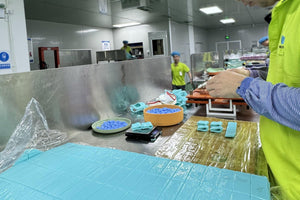Silicone compression molding is a manufacturing process used to produce high-quality, durable, and intricate silicone products. From automotive components to medical devices, electronic housings to kitchenware, silicone compression molding offers unparalleled versatility and precision. This guide delves into the specifics of the silicone compression molding process, its advantages, applications, and key considerations for manufacturers and designers.
1. What is Silicone Compression Molding?
Silicone compression molding is a form of compression molding that involves placing a pre-measured amount of liquid silicone rubber (LSR) into a heated mold cavity. The mold is then closed, applying pressure to the material. This process causes the silicone to flow and take the shape of the cavity, curing as it cools to create a solid product. Unlike traditional compression molding, which typically uses thermosetting resins, silicone compression molding utilizes silicone rubber, which is known for its excellent heat resistance, flexibility, and biocompatibility.
2. The Silicone Compression Molding Process
The silicone compression molding process is relatively straightforward but requires precision and attention to detail. Here are the basic steps involved:
Step 1: Material Preparation
Liquid silicone rubber (LSR) or solid silicone rubber (SSR) is prepared based on the specifications of the final product. The material is often pre-measured and mixed with curing agents to ensure proper curing during molding.
Step 2: Mold Setup
The mold itself is created to match the desired shape and features of the final product. Typically, molds are made from metals such as aluminum or steel, which offer both durability and thermal conductivity. The mold is preheated to a specific temperature to facilitate the curing process.
Step 3: Material Injection
The prepared silicone rubber is placed into the cavity of the mold. Depending on the design, the material can be in liquid form (LSR) or solid form (SSR). In the case of LSR, the material may be injected directly into the mold or placed manually into the cavity.
Step 4: Compression and Curing
Once the mold is filled, the two halves of the mold are brought together with a controlled amount of pressure. The pressure ensures that the silicone rubber fully fills the mold cavity, eliminating air pockets and ensuring the uniformity of the product. At the same time, the heat applied causes the silicone to cure and harden.
Step 5: Mold Opening and Ejection
After the curing process is complete, the mold is opened, and the finished part is ejected. The molded silicone part may require additional post-processing, such as trimming or surface finishing, depending on the specific requirements.
3. Advantages of Silicone Compression Molding
Silicone compression molding offers numerous benefits, making it an ideal choice for producing silicone products across various industries.
a. High Precision and Detail
Silicone compression molding is capable of producing highly detailed parts with intricate geometries. The mold cavity can be engineered to include features such as thin walls, complex undercuts, and fine textures, allowing for the production of sophisticated and high-quality components.
b. Cost-Effectiveness for High-Volume Production
Although the initial cost of creating a mold can be significant, the compression molding process becomes more cost-effective as production volumes increase. The tooling costs are spread across a larger number of parts, making it a highly economical choice for mass production runs.
c. Excellent Material Properties
Silicone rubber offers exceptional thermal stability, chemical resistance, flexibility, and biocompatibility. These properties make it suitable for demanding applications, including automotive, medical, food, and consumer goods. Silicone parts produced through compression molding maintain their integrity even under extreme temperature fluctuations or harsh environmental conditions.
d. Versatility in Product Design
Silicone compression molding can be used to create a wide range of products, from simple gaskets and seals to complex electronic components and medical devices. The flexibility of silicone allows manufacturers to design parts that are flexible, resilient, and resistant to wear and tear.
e. Reduced Waste
Compared to some other molding processes, silicone compression molding minimizes material waste. The pre-measured amounts of silicone ensure that the right amount of material is used for each part, reducing scrap and optimizing resource usage.
4. Applications of Silicone Compression Molding
The versatility of silicone rubber makes compression molding an ideal method for producing parts across various industries. Here are some common applications:
a. Automotive Industry
Silicone parts are widely used in the automotive sector for components such as gaskets, seals, hoses, and O-rings. These parts must withstand extreme temperatures, UV exposure, and chemicals, all of which silicone handles exceptionally well.
b. Medical and Healthcare
Silicone’s biocompatibility makes it a go-to material for medical devices, including surgical instruments, prosthetics, seals for medical equipment, and baby products like pacifiers and teething rings. Silicone compression molding ensures high-quality, precise components that meet stringent medical standards.
c. Electronics and Electrical
Silicone is used in electronics for components like connectors, seals, and gaskets. These parts need to be resistant to heat, moisture, and electrical interference. Silicone compression molding helps manufacturers create protective housings and insulating components that can endure harsh environments.
d. Consumer Goods and Kitchenware
Silicone’s non-reactivity and heat resistance make it an excellent material for cookware, bakeware, and household products. Items such as baking mats, spatulas, trivets, and baby bottles are often made using silicone compression molding due to their durability and safety.
e. Industrial and Aerospace
In industrial and aerospace applications, silicone parts must meet rigorous standards for heat resistance, chemical resistance, and durability. Compression molding allows manufacturers to produce seals, gaskets, and other high-performance components for these industries.
5. Key Considerations for Silicone Compression Molding
While silicone compression molding offers many benefits, manufacturers must consider several factors to ensure optimal results:
a. Mold Design and Tooling
The quality of the mold plays a significant role in the final product. Engineers must design molds with precise tolerances and ensure they are durable enough for repeated use. Initial tooling costs can be high, but they are spread out over larger production volumes.
b. Cure Time and Temperature
The curing process is critical to the success of silicone compression molding. The time and temperature required to cure the silicone vary depending on the material, mold design, and part thickness. Proper monitoring of curing parameters is essential to ensure consistency and quality.
c. Material Selection
Choosing the right type of silicone is crucial to the performance of the final product. Manufacturers must consider factors such as temperature resistance, flexibility, and chemical exposure when selecting the silicone rubber for compression molding.
d. Post-Processing and Quality Control
After molding, some silicone products may require trimming, surface finishing, or additional inspections. Ensuring proper post-processing can improve the final product’s aesthetics and functionality. Rigorous quality control processes are also necessary to meet industry standards and specifications.
Conclusion
Silicone compression molding is a highly effective manufacturing method for producing precision-engineered silicone components with exceptional durability, flexibility, and performance. With its cost-effectiveness for high-volume production and ability to create complex designs, silicone compression molding is an indispensable process across various industries, including automotive, medical, electronics, and consumer goods.
For manufacturers, understanding the intricacies of the silicone compression molding process is essential to achieving optimal results. With proper material selection, mold design, and quality control, businesses can leverage the benefits of this versatile process to create high-quality products that meet the most demanding specifications. Whether you're producing automotive gaskets or medical devices, silicone compression molding offers a reliable and efficient solution for high-performance, long-lasting products.
About Author
We are dedicated to pushing the boundaries of possibility in silicone product manufacturing and our extensive range of inhouse designs and molds across baby, pet, homewares and more allows companies to customize and create products specific for their brand and market needs.
Whether you are looking for a company to bring your ideas and brand to life or looking for ready to go items with packaging and branding, WOLIFE is ready to help your business grow.
WOLIFE looks forward to collaborating with you!


 Using LSR in Hearing Components
Using LSR in Hearing Components Why Silicone Cooking Utensils and Baking Trays Don’t Melt – The Science Explained
Why Silicone Cooking Utensils and Baking Trays Don’t Melt – The Science Explained 10 Creative Products You Didn’t Know Could Be Made with Silicone
10 Creative Products You Didn’t Know Could Be Made with Silicone Common Quality Control Challenges in Silicone Manufacturing
Common Quality Control Challenges in Silicone Manufacturing